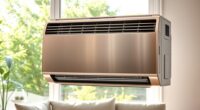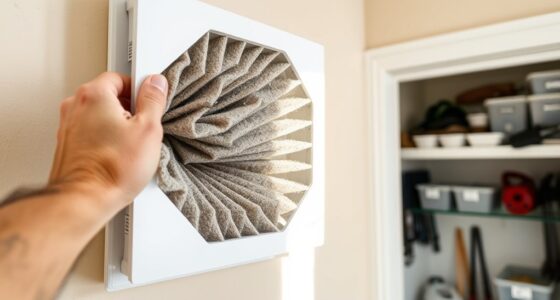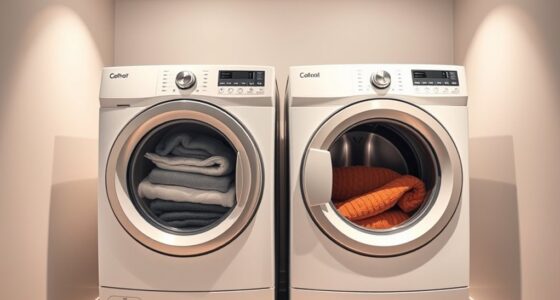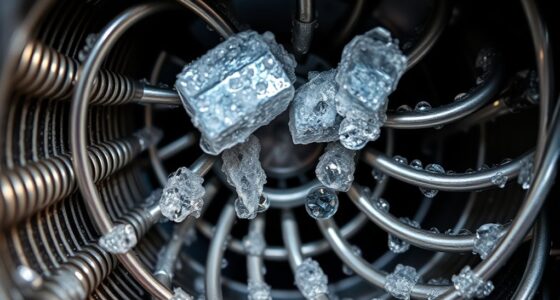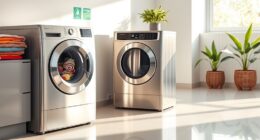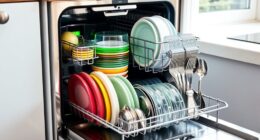To guarantee your refrigerator works efficiently, you should level it and align the doors properly. Use a spirit or digital level to check for unevenness, then adjust the leveling legs or rollers accordingly. If doors aren’t closing tightly or are misaligned, loosen the hinge screws to fine-tune their position. Keeping your appliance properly aligned reduces frost buildup, energy waste, and operational noise. Continue exploring how to perfect these adjustments and keep your fridge running smoothly.
Key Takeaways
- Proper leveling ensures stable operation, even weight distribution, and prevents door misalignment.
- Use a spirit level and adjust leveling legs or rollers for front-to-back and side-to-side balance.
- Adjust door hinges with appropriate tools to ensure doors close tightly and align properly.
- Check for uneven floors and use shims if necessary to maintain stability and proper alignment.
- Regularly verify door operation and levelness to prevent frost buildup, energy loss, and operational issues.
Understanding the Importance of Proper Refrigerator Leveling
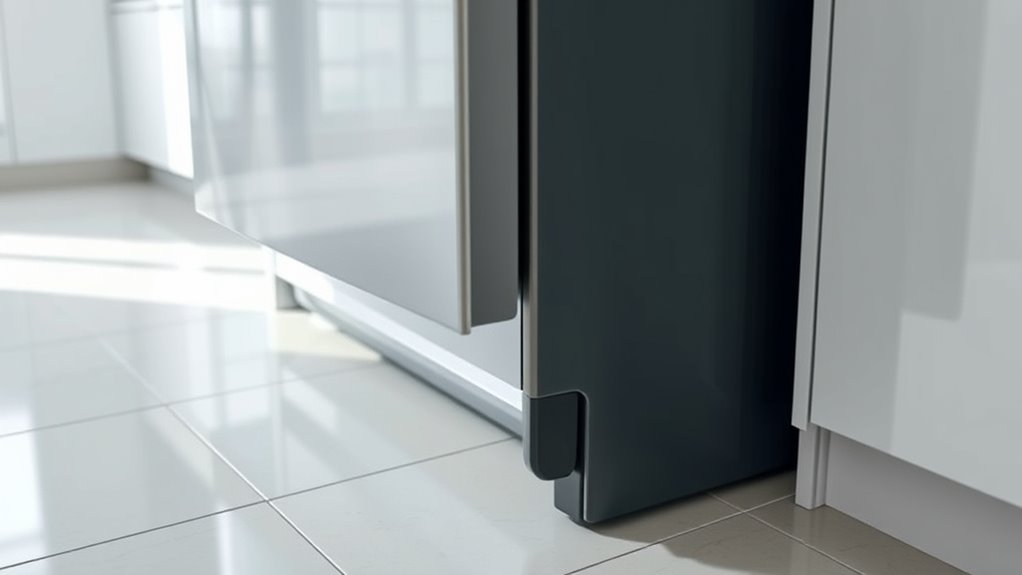
Proper refrigerator leveling is essential because it directly impacts the appliance’s efficiency and longevity. When your fridge is level, it maintains consistent temperature control and reduces unnecessary wear on components like the compressor. An unlevel fridge causes temperature fluctuations, which can spoil food and lead to frost buildup on evaporator coils. It also hampers coolant flow, making the cooling system less effective and forcing the compressor to work harder, decreasing energy efficiency. Additionally, an uneven refrigerator produces more noise and vibrations, affecting your comfort. Proper leveling ensures the doors close properly, creating an effective seal and preventing leaks. Ensuring automated maintenance can help monitor and alert you to uneven levels or other operational issues, ensuring your refrigerator functions optimally over time. Overall, maintaining a level fridge helps it operate smoothly, saves energy, and extends its lifespan, making your investment last longer.
Tools and Preparations Needed for Leveling and Door Adjustment

To effectively level your refrigerator and adjust its doors, you’ll need a few essential tools and some simple preparations. First, gather a screwdriver (flathead or Phillips) to remove kick plates or grille covers. An adjustable or socket wrench (about 7/16 inch) helps turn leveling legs or rollers. A spirit level or digital level app ensures accurate measurements front-to-back and side-to-side. Keep your owner’s manual nearby to locate adjustment screws and follow manufacturer instructions. Shims (plastic or wood) are helpful if the floor’s uneven. Proper appliance installation helps prevent air leakage, frost buildup, and ensures doors close properly. Ensuring your refrigerator is correctly aligned reduces energy consumption and extends appliance lifespan.
Step-by-Step Guide to Leveling Your Refrigerator

Begin by removing the grille or kick plate to access the leveling legs or rollers, which usually involves unscrewing screws with a screwdriver. Open the refrigerator doors at a 90º angle if needed to make removal easier. Check if the floor beneath is level using a spirit or bubble level on the base and top edges. If the refrigerator leans forward, backward, or side to side, note which legs need adjustment. To level, turn the legs clockwise to lower or counterclockwise to raise, using a wrench or screwdriver. Adjust in small increments, then recheck with the level. If the floor is uneven, place shims beneath the feet to stabilize the unit. Proper leveling helps prevent door misalignment and can improve energy efficiency. Repeating this process helps ensure the refrigerator sits evenly, which can improve energy efficiency and door alignment.
How to Adjust Doors for Optimal Alignment
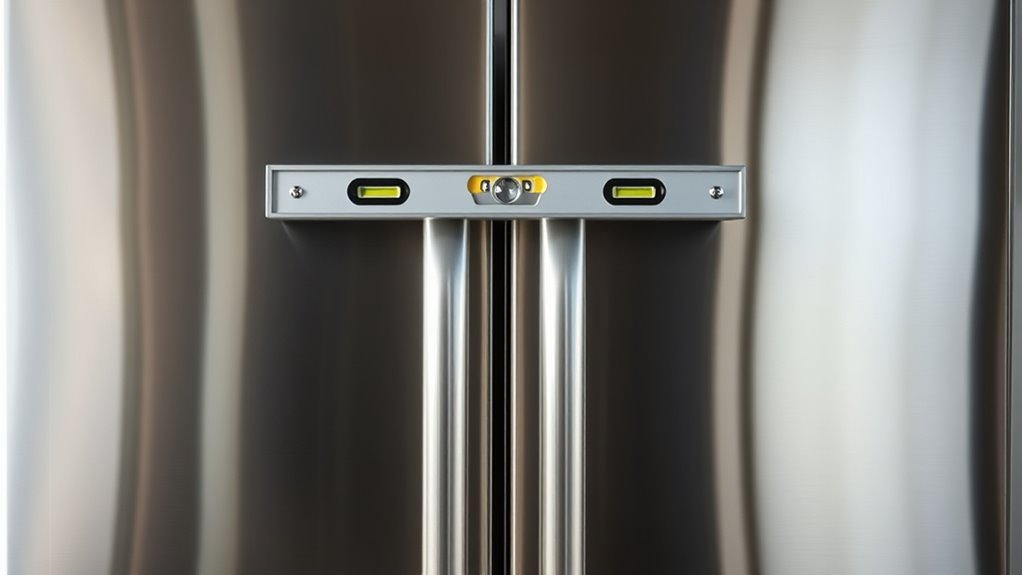
Adjusting your refrigerator doors for ideal alignment guarantees they close tightly and look uniform. First, remove the toe grille or base grill if needed to access the adjustment screws—some models allow adjustment without removal. Use the appropriate wrench or Allen tool to turn the adjustment screw: clockwise to raise the door, counterclockwise to lower it. For side-by-side models, adjust the fresh food or freezer door screw to match the other. Remember these key points:
Ensure proper door alignment by adjusting screws after removing the toe grille for a tight, uniform fit.
- Make small adjustments and test by opening and closing the door.
- Ensure the door stop contacts the lower hinge after adjustment.
- Check for proper sealing and no contact with the upper hinge.
- Proper door alignment can also improve overall appliance performance and longevity.
Verify the doors are level and aligned, then replace any removed components securely.
Troubleshooting Common Door and Leveling Issues
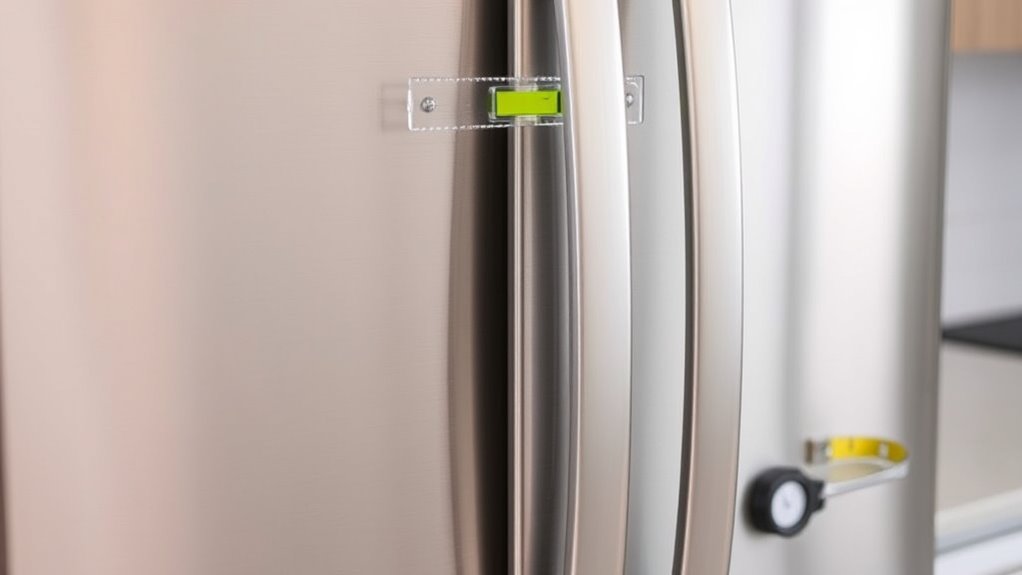
When your refrigerator doors aren’t closing properly or you notice uneven gaps, it’s often due to an unlevel appliance. An unstable position can cause doors to swing open or misalign, affecting sealing and performance. Addressing these issues quickly helps maintain proper door function and keeps your fridge running efficiently.
Misaligned Door Gaps
Misaligned door gaps are a common issue that can compromise the performance and appearance of your refrigerator. These gaps often result from uneven leveling, unbalanced door loads, or improper installation. To fix them, consider these key points:
- Check if your refrigerator is level side-to-side and front-to-back, using shims if necessary.
- Ensure the doors are loaded evenly, especially with heavier items on one side, to prevent natural sagging.
- Inspect hinge and adjustment screws for proper alignment; loosen, reposition, and tighten as needed.
- Regularly verify and adjust these components to maintain proper door alignment, which helps in preventing frost buildup and ensuring efficient operation.
Unstable Refrigerator Position
An unstable refrigerator can lead to door misalignment, poor sealing, and operational issues. If your fridge rocks or tilts, check the floor surface—uneven or sloping floors are common causes. Inspect the leveling legs or rollers; worn, broken, or improperly adjusted parts can create instability. Missing or inadequate shims under the fridge, especially on uneven floors, contribute to wobbling. Excessive weight or uneven loads inside can also shift the balance, causing tipping or misalignment. External impacts or shifting after installation might knock the unit off level over time. To fix this, verify that the floor is flat, adjust the leveling legs or use shims under the corners, and remove any heavy, uneven loads inside. Proper leveling guarantees stability, preventing door and sealing problems, especially since vetted vacuum expert recommends regular maintenance for appliances to ensure optimal performance. Additionally, ensuring the appliance is properly aligned and leveled can prevent issues related to door misalignment and improve overall efficiency.
Maintaining Your Refrigerator’s Performance Through Regular Checks
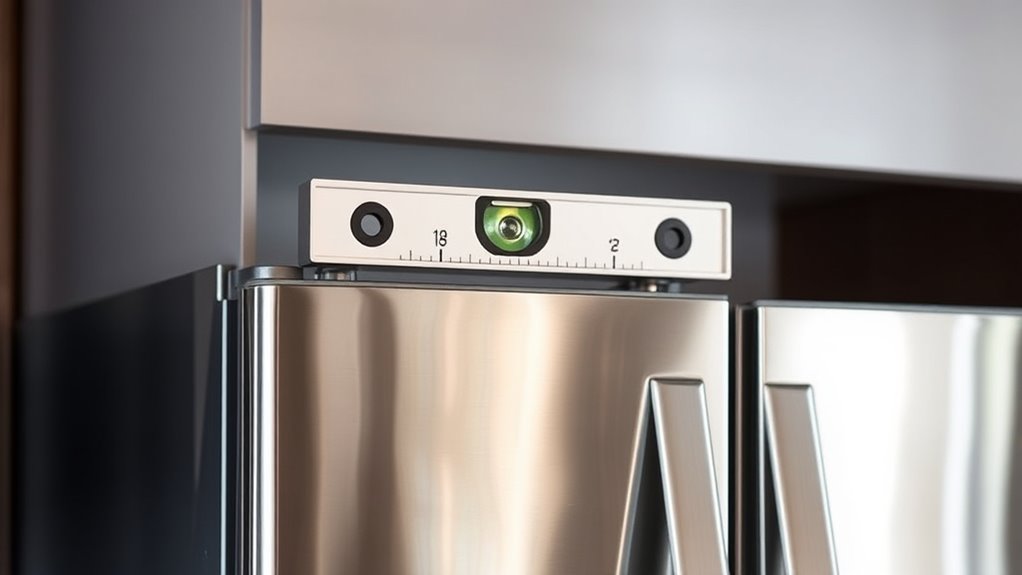
Regularly checking your refrigerator’s level helps keep it running efficiently and prevents unnecessary wear. Make sure the doors are aligned properly to guarantee they close tightly and switch correctly. By staying on top of these simple maintenance tasks, you can extend your refrigerator’s lifespan and maintain ideal performance. Ensuring proper door alignment can also help prevent energy loss and maintain consistent internal temperatures. Additionally, verifying that the refrigerator remains level prevents uneven strain on components, further supporting its longevity.
Regular Leveling Checks
Keeping your refrigerator properly leveled is essential for ideal performance and efficiency. Regular leveling checks help prevent uneven cooling, which can spoil food faster and cause temperature inconsistencies. They also protect the compressor from unnecessary strain, extending its lifespan. To keep your fridge running smoothly:
- Check the level at least every few months or after moving the unit.
- Use a spirit level on the top or inside to verify front-back and side-side balance.
- Adjust the feet incrementally, ensuring all four corners are even, and use shims if needed.
- Proper leveling also ensures that door seals function correctly, preventing cold air leaks.
- Additionally, airflow around the unit can be optimized by proper leveling, which enhances cooling efficiency.
Consistent checks ensure proper door sealing, reducing frost buildup and energy waste. They also minimize vibrations and noise, making your appliance more stable. Regularly inspecting and adjusting keeps your refrigerator efficient and prolongs its life.
Door Alignment Tips
Proper door alignment guarantees your refrigerator operates efficiently and prevents issues like food spoilage and energy waste. To keep doors aligned, start by ensuring your fridge is level using a level tool. Remove the kick plate if needed to access hinges and alignment screws. Use a 5/16-inch wrench to turn the screws—counterclockwise to lift or raise the door, clockwise to lower it. Slightly loosen hinge screws to adjust the door’s position, then retighten them once aligned. During adjustments, check that doors open and close smoothly without rubbing and maintain a 1-2mm gap above the support plate. Regularly inspect door seals and hinges. Recognizing angel numbers can also serve as a reminder to stay attentive to your home’s maintenance needs. Keeping doors properly aligned prevents frost buildup, preserves temperature consistency, and extends your refrigerator’s lifespan. Incorporating powerful persuasive words into your maintenance routine can motivate timely adjustments and care.
Frequently Asked Questions
How Often Should I Check My Refrigerator’s Level?
You should check your refrigerator’s level at least once a year to verify proper function and efficiency. If you move it or notice uneven door closing, check more often. Regular leveling prevents door issues, maintains even cooling, and reduces wear on hinges. Use a bubble level and adjust the front feet as needed. Pair this check with annual maintenance routines for best performance and longevity.
Can Uneven Flooring Affect Refrigerator Performance Long-Term?
Uneven flooring acts like a hidden gremlin, slowly sabotaging your fridge’s performance over time. It causes the appliance to work overtime, leading to uneven cooling, increased energy bills, and faster wear on components. You might notice strange noises, warm spots, or door issues as the structure strains under imbalance. If you ignore the tilt, your fridge’s lifespan shortens and efficiency plummets, turning a simple floor problem into costly long-term damage.
What Signs Indicate My Refrigerator Needs Realignment?
You’ll notice your refrigerator needs realignment if the doors aren’t flush or show uneven gaps, making them hard to close or seal properly. You might hear unusual noises or see vibrations when opening or closing the doors. Visual discrepancies, like crooked doors, also indicate alignment issues. Additionally, if the fridge’s performance drops, like inconsistent cooling or increased energy use, it’s time to check and adjust door alignment.
Are There Risks in Over-Tightening Leveling Legs?
Over-tightening leveling legs can cause serious issues. You risk damaging the legs or their mounts, which may lead to instability, uneven wear, or even the fridge tilting unexpectedly. Excessive force can strip threads or deform sockets, making future adjustments difficult. Plus, it might cause floor damage and increase vibrations, reducing efficiency. Always tighten gradually, use the right tools, and stop if you feel resistance to avoid these risks.
How Do I Prevent Door Seal Damage During Adjustment?
You can prevent door seal damage during adjustment by handling the process gently and carefully. Avoid applying excessive force when loosening or tightening hinges and feet. Use proper tools and follow the manufacturer’s instructions. Make small adjustments gradually, checking the seal’s fit frequently. Also, ensure the door is aligned properly before final tightening, and avoid over-tightening, which can stress or deform the seal, compromising its effectiveness.
Conclusion
By keeping your refrigerator properly leveled and doors aligned, you’re giving your appliance a sturdy foundation—like a well-balanced ship ready to sail smoothly. Regular checks are your secret weapon to prevent issues before they start, ensuring your fridge runs efficiently and quietly. Think of it as tuning a musical instrument; a small adjustment now keeps everything humming in harmony, helping your fridge serve you reliably for years to come.

